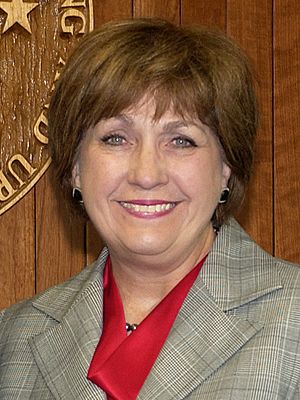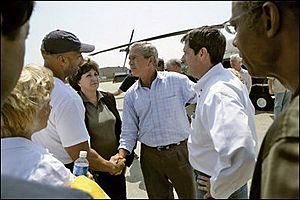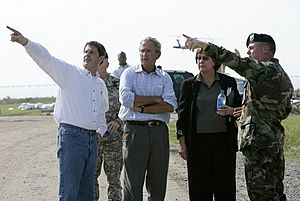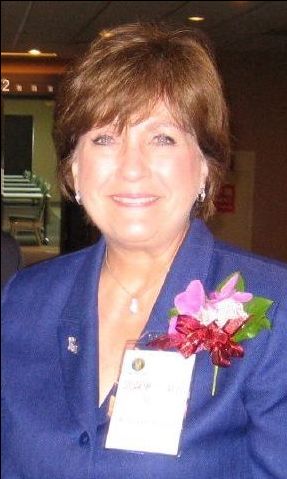Kathleen Blanco facts for kids
Quick facts for kids
Kathleen Blanco
|
|
|---|---|
 |
|
| 54th Governor of Louisiana | |
| In office January 12, 2004 – January 14, 2008 |
|
| Lieutenant | Mitch Landrieu |
| Preceded by | Mike Foster |
| Succeeded by | Bobby Jindal |
| 50th Lieutenant Governor of Louisiana | |
| In office January 8, 1996 – January 12, 2004 |
|
| Governor | Mike Foster |
| Preceded by | Melinda Schwegmann |
| Succeeded by | Mitch Landrieu |
| Member of the Louisiana Public Service Commission from the 2nd district |
|
| In office January 1, 1989 – January 8, 1996 |
|
| Succeeded by | Jimmy Field |
| Member of the Louisiana House of Representatives from the 45th district |
|
| In office March 12, 1984 – January 1, 1989 |
|
| Preceded by | Luke LeBlanc |
| Succeeded by | Jerry LeBlanc |
| Personal details | |
| Born |
Kathleen Marie Babineaux
December 15, 1942 New Iberia, Louisiana, U.S. |
| Died | August 18, 2019 (aged 76) Lafayette, Louisiana, U.S. |
| Political party | Democratic |
| Spouse |
Raymond Blanco
(m. 1964) |
| Children | 6 |
| Education | University of Louisiana, Lafayette (BS) |
Kathleen Marie Blanco (born Babineaux; December 15, 1942 – August 18, 2019) was an American politician. She served as the 54th governor of Louisiana from 2004 to 2008. She was a member of the Democratic Party. Kathleen Blanco was the first and only woman to be elected as Louisiana's governor.
When she first became governor, Blanco focused on important goals. These included making healthcare more affordable, making the education system better, and helping the state's economy grow. However, her time as governor changed a lot in 2005. Two major hurricanes, Hurricane Katrina and Hurricane Rita, hit Louisiana within a month. These storms caused huge damage, destroying many homes and businesses. About one million people lost their homes due to severe flooding.
Many people felt that the first response from the city, state, and federal governments was not good enough. Governor Blanco later said that her administration made mistakes. However, a lot of the criticism also went to the Federal Emergency Management Agency (FEMA) and President Bush. People felt they were too slow to respond and did not manage help effectively.
In 2007, Blanco announced she would not run for re-election. She wanted to focus on her work for the people, not on politics. She was diagnosed with cancer in 2011 and passed away on August 18, 2019.
Contents
Early Life and Political Start
Kathleen Marie Babineaux was born in New Iberia, Louisiana. Her parents, Louis and Lucille, were of Cajun background. Her grandfather was a farmer and grocer. Her father was a small businessman. Kathleen went to Mount Carmel Academy, an all-girls Catholic school. In 1964, she earned a degree in business education from the University of Louisiana at Lafayette. She married Raymond Blanco in 1964, and they had six children.
After college, Blanco taught business at Breaux Bridge High School. She then spent about 15 years as a stay-at-home mom. Later, she worked for the United States Department of Commerce during the 1980 Census. She also owned a research firm with her husband.
Before becoming governor, Blanco worked in public office for 20 years. In 1983, she became the first woman elected to the Louisiana House of Representatives from Lafayette. She was one of only five women in the state legislature at that time. In 1988, she became the first woman elected to the Louisiana Public Service Commission. She also served as the first woman chairman of the PSC. After that, she was elected Lieutenant Governor and held that position for eight years.
Serving as Governor of Louisiana
Kathleen Blanco was elected governor on November 15, 2003. She won against Bobby Jindal in the election. On January 12, 2004, she officially became governor. She took her oath of office in both English and French.
As governor, Blanco worked hard to bring new businesses to Louisiana. She traveled to places like Nova Scotia, Cuba, Japan, China, and Taiwan to help the state's economy grow. Despite the challenges from the hurricanes, she met her main goals. She focused on improving education from pre-kindergarten all the way to universities. She also set up plans to help Louisiana's coast recover.
Blanco was a member of important groups like the National Governors Association. She also led the Southern Governors' Association.
Dealing with Hurricane Katrina

On August 27, 2005, Hurricane Katrina was approaching. Governor Blanco said Louisiana was prepared. Later that day, she asked President Bush for federal help and money. She explained that the disaster was too big for the state and local governments to handle alone.
The FEMA and President Bush quickly approved federal resources. On August 28, Blanco asked for even more aid. Many people were evacuated from New Orleans. Over 60,000 people were rescued after the storm. As the leader of the Louisiana National Guard, Blanco asked other governors for help. Nearly 40,000 troops from other states came to Louisiana. This was one of the largest troop deployments in the nation's history for a disaster.
On September 1, 2005, with reports of looting, Blanco sent 300 Louisiana National Guardsmen to help the New Orleans Police Department. President Bush visited Louisiana on September 2, 2005. He offered to put the Louisiana National Guard under federal control. Governor Blanco said no to this offer. She wanted the Guard to stay under state control so they could continue to act as police officers. This was important for stopping looting and keeping order.
On September 14, President Bush took responsibility for federal problems. Governor Blanco also took responsibility for problems at the state level. She said, "The buck stops here, and as your governor, I take full responsibility."
Aftermath and Recovery Efforts
After the hurricanes, Governor Blanco kept asking President Bush and Congress for more money to help Louisiana recover. She pointed out that Louisiana needed more help compared to other states affected by the storms.
In 2006, Blanco was honored by being added to the Louisiana Political Museum and Hall of Fame. On March 20, 2007, she announced that she would not run for governor again. Bobby Jindal became the next governor on January 14, 2008.
Health and Passing
Kathleen Blanco was first diagnosed with cancer in 2011. She received treatment and the cancer went away for a while. In December 2017, her cancer returned. A year later, she shared that the cancer had spread throughout her body. She said she had "made peace" with her future. On April 19, 2019, it was announced that she was receiving hospice care.
Kathleen Blanco passed away on August 18, 2019, in Lafayette, Louisiana.
Governor John Bel Edwards ordered flags across Louisiana to be lowered to half-staff until August 24, 2019, to honor her.
See also
 In Spanish: Kathleen Blanco para niños
In Spanish: Kathleen Blanco para niños
- List of female governors in the United States
- List of female lieutenant governors in the United States



